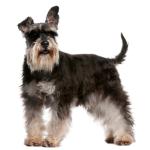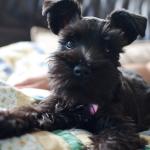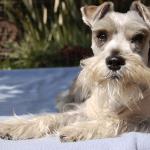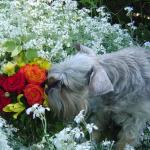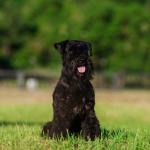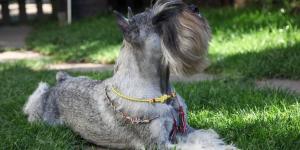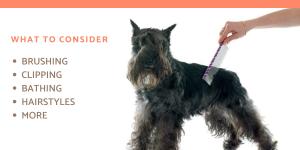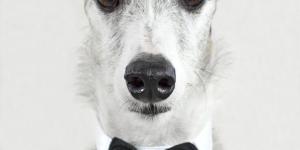Standard schnauzer

The schnauzer is an elegant, agile and robust dog, characterized by their great intelligence and loyalty. Informally they are also called the standard schnauzer - but this is not the official name of the breed. These dogs are very curious, intelligent and of an incomparable character. They are really loyal and noble life companions, perfect for any kind of family.
They show very peculiar physical characteristics that make them popular in countries all over the world. Of course, their eyebrows and mustache.
In this AnimalWised breed file we will inform you of how the standard schnauzer should be cared for and trained. Everything you need to know before adopting one is down below.
- Europe
- Germany
- Group II
- 5-14
- 14-18
- 18-22
- 22-27
- 27-31
- More than 31
- 2-7
- 7-22
- 22-55
- 55-100
- 100-220
- 8-10
- 10-12
- 12-14
- 15-20
- Low
- Meidum
- High
Origin of the schnauzer
The schnauzer, unsurprisingly, originates from Germany. This is where they accompanied the carriages, tended the stables and killed rodents and other vermin. In addition, they were much appreciated as a companion dog and to take care of children. In the late 1800s, the breed was first introduced to a dog show. However, they were presented as a hard-haired pinscher. Subsequently and referring to their characteristic beard and mustache, they were given the name of schnauzer. Which, derives from the German word "schnauze" meaning snout.
Over time this breed was crossed with other breeds to look for the same qualities in different sizes. The schnauzer then helped create the giant schnauzer and the miniature schnauzer. Today the schnauzer is an excellent companion dog, working and exhibiting.
Physical characteristics of the schnauzer
In general terms, this dog is a very elegant animal, with a square profile (height at the cross equal to the length of the body) and haughty appearance. They are of medium size, with a compact and rough coat. The dorsal line descends slightly from the cross to the back. Their back is short and strong, while the rump is slightly rounded. Their chest is moderately deep, reaching to the elbows. Their flanks are gathered in the belly, but not exaggeratedly.
The head of the schnauzer is covered with thick fur that forms prominent eyebrows, and is strong and long. Their forehead is flat and the occiput slightly marked. Their length corresponds approximately to the half of the length of the body (measured from the cross to the base of the tail). Their stop, or naso-frontal depression, is very evident below the eyebrows. Their muzzle is straight and has a truncated wedge shape. Their nose is broad and black, while the lips, also black, are well glued on the jaws.
The eyes of this dog are oval, medium and face forward. They have a lively expression. Their ears are V-shaped and fall forward. These ears used to be cropped, but the current standard of the International Cynological Federation (FCI) requires complete ears.
The tail should be natural and have the shape of a saber or sickle. Formerly amputated, but fortunately for dogs, the current breed standard requires natural tails.
The hair is formed by two layers. The outer layer is rough and moderately long, without being hirsute or undulating. The inner layer is a thick wool. The coat of the head is very characteristic of the breed, forming eyebrows on the forehead and a thick beard on the muzzle. For this race only two varieties of color are accepted, pure black with black inner wool and "salt and pepper". However we can find schnauzer of different colors and combinations.
The height at the cross is 45 to 50 centimeters, for both males and females. The ideal weight, for its part, goes from 14 to 20 kilograms for both male and female dogs.
Schnauzer temperament
Schnauzer dogs have a strong personality and are often very sure of themselves. They are intrepid and confident, and many may even seem arrogant. In spite of this, or perhaps because of this, their temperament is usually very stable and they are reliable and loyal dogs.
It is very important to socialize them from puppies so that their strong personality does not cause problems later. Properly socialized dogs get along well and tolerate other dogs and other pets well. However, if the education and socialization of dogs is not done correctly and at an early age, the schnauzer can react badly to other dogs of the same sex. They can also act like hunters of small animals and be relatively reserved with strangers.
Caring for a schnauzer
When it comes to dog training, they respond very well as long as they receive fair and respectful treatment. Exceptional results can be achieved when you train them consistently and with positive methods.
Schnauzers are active dogs that need physical and mental exercise. When they do not get enough exercise they can become destructive dogs. However, the most conflictive behavior problem in this breed is that of guarding resources. To avoid this, it is very important to socialize them from an early age and teach them canine obedience exercises that help develop self-control.
When properly socialized and educated, schnauzer dogs are excellent pets for individuals and families alike. Especially those who enjoy moderate physical activity. They are also excellent pets for families with large children as they get along well with them. However, they are not the most suitable breed for families with very young children. They can react badly to the mischief and unconscious abuse of the little ones.
The coat requires a little regular effort to keep it healthy and shiny. Daily brushing is usually enough to prevent it from getting tangled up. You will have to take the dog to the dog hairdresser about three or four times a year to shape and help care for the hair.
Moderate exercise is necessary for these dogs. Although they are not as active as giant schnauzers, they do require two to three daily walks and some play time. They can also participate in canine sports such as agility or canine freestyle, but avoid sudden jumps when dogs are still not fully developed. They are excellent companions of trot and walks.
These dogs have a strong and somewhat independent character, but need frequent companionship. Schnauzers are not fit to be left alone all day since that is when they begin to develop strong separation anxiety. They are very social pets that will thank a playmate.
On the other hand, they can live very well in an apartment provided they receive enough walks and exercise, but it is better if they have a garden where they can run freely. Ideally, they can use the yard or garden to exercise (in addition to their daily walks), but sleep in the house.
Training a schnauzer
The schnauzer dog being extremely sociable, has a natural predisposition to follow the game and our indications. Especially if you include positive reinforcement as the basis of their education. They will respond wonderfully to treats and goodies. But for the schnauzer to be a truly sociable dog, we must actively work on their socialization, which will begin when they are a puppy and will continue throughout their adulthood.
Even so, the schnauzer can be somewhat stubborn, so working basic obedience will be a priority in this breed.
Finally we encourage you to take long walks with your pet so they can enjoy their surroundings and enrich their day to day life. They are grateful and noble dogs that will not hesitate to offer us all their love if we treat them with affection and respect.
Schnauzer health
Unlike many other breeds, the schnauzer tends to be a healthy dog without high incidences of hereditary diseases. However, it occasionally exhibits follicular dermatitis and may suffer from hip dysplasia.
Even if you have a healthy dog, it is important that you follow the usual dog health routines that include veterinary visits every 6 months, deworming and tracking the vaccination schedule. Properly following these guidelines will help us detect any ailments quickly.
Standard schnauzer photos
